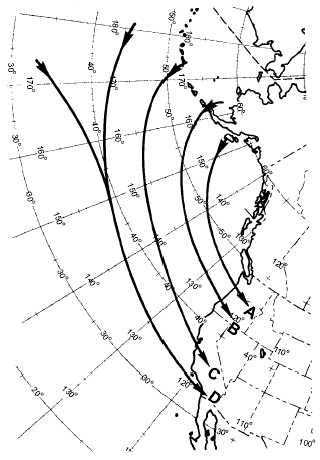visibility is low. Icing conditions, generally quite
severe, are present in the clouds. After this mP air has
been over land for several days, it has stabilized and
weather conditions improve significantly.
TRAJECTORY
PATHS
B
AND
C
(CYCLONIC).—Trajectory paths B and C air with a
longer overwater trajectory dominate the west coast of
the United States during winter months. When there is
rapid west-to-east motion and small north-to-south
motion of pressure systems, mP air may influence the
weather over most of the United States. Because of a
longer overwater trajectory, this mP air is heated to
greater heights, and convective instability is present up
to about 10,000 feet.
This air has typical k characteristics—turbulent
gusty winds, steep lapse rate, good visibility at ground
except 0 to 3 miles in precipitation, as well as cumulus
and
cumulonimbus
clouds
with
showers.
These
showers are not as intense as those produced in the
shorter trajectory mP air, but the total amount of
precipitation is greater.
TRAJECTORY
PATH
D
(ANTI-
CYCLONIC).—This trajectory usually is over water
long
enough
to
permit
modifications
to
reach
equilibrium at all levels. When the air reaches the coast,
it is very stable with one or two subsidence inversions.
Stratus or stratocumulus clouds are frequently found.
Ceilings are usually 500 to 1,500 feet and the tops of
clouds are generally less than 4,000 feet. Visibility is
fair except during the early morning hours when haze
and smoke reduce the visibility to less than 1 mile. This
type of air is found over the entire Pacific coast. It is
incorrectly referred to as mT air, since it follows the
northern boundary of the Pacific anticyclone. However,
mT air does on rare occasions move into California
along this path.
Gradually
mP
air
drifts
eastward
with
the
prevailing west-east circulation. In crossing the coastal
ranges and the Rocky Mountains, much of the moisture
in the lower layers is condensed out; the heat of
condensation liberated is absorbed by the intermediate
layers of air. On the eastern slopes of the mountains, the
air is warmed as it descends dry-adiabatically. As it
flows over the cold and often snow-covered land
surface east of the mountains, the warm mP air
becomes stable in the lower layers.
The flying conditions in mP air east of the Rocky
Mountains are in general the best that are experienced
in winter. Relatively large diurnal temperature ranges
are observed. Turbulence is almost absent and visibility
is good, except for the smoke and haze in industrial
areas. Ceilings are generally unlimited, since either no
clouds or only a few high clouds are present. This type
of mild winter weather occasionally spreads eastward
to the Atlantic coast. When mP air crosses the Rocky
Mountains and encounters a deep, dense dome of cP air,
it is forced to overrun it and results in storm conditions
that produce blizzards over the plains states.
Maritime Tropical (mT) Air Pacific in Winter
Maritime tropical (mT) air is observed only
infrequently on the Pacific coast, particularly near the
surface. Air flowing around the northern boundary of
the Pacific anticyclone is at times mT air but is usually
mP air. This air has the weather characteristics (as well
as the low temperature) of mP air, having had a long
trajectory over the water. (See fig. 4-9.)
Occasionally the eastern cell of the Pacific
anticyclone splits, and one portion moves southward
off the coast of southern California. This portion of the
anticyclone is then able to produce an influx of mT air.
4-10
AG5f0408
Figure 4-8.—Trajectories of mP air over the Pacific Coast in
winter.


